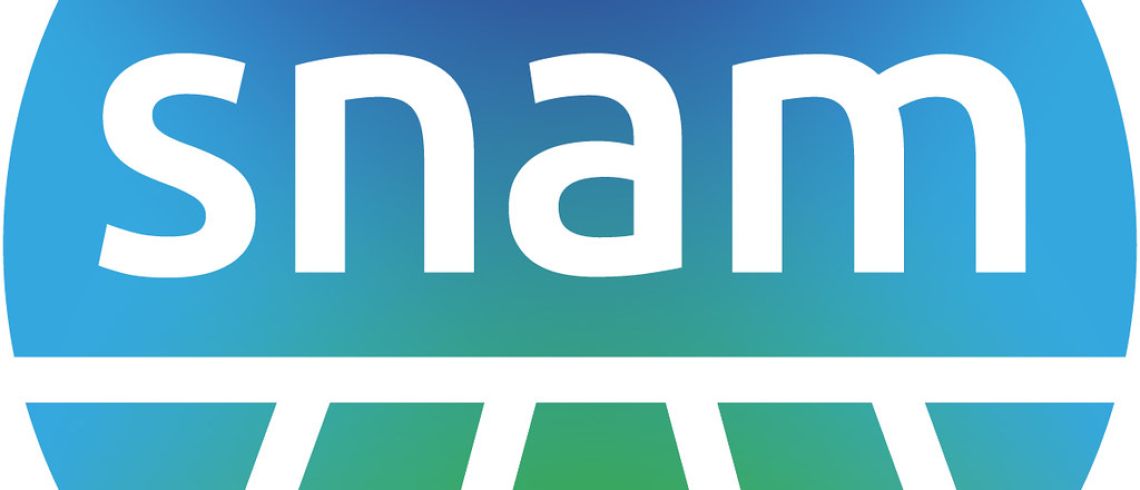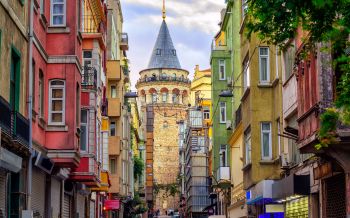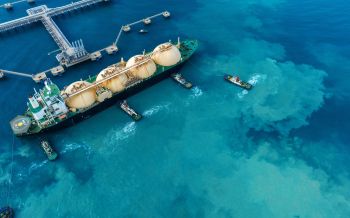Elio Ruggeri, executive director for LNG at Italian gas network operator Snam, oversees the group’s regas terminals, both in operation and under development. He began working in the gas industry in the mid-1990s. Before joining Snam in 2018, he was in charge of gas supply and infrastructures at Italian energy company Edison, now owned by EDF, where he dealt with international projects and contract negotiations with suppliers.
The Russia-Ukraine war has had a massive impact on Italy, whose energy mix has long relied on natural gas, almost all of it imported. In 2022, Russia supplied Italy with 19% of the gas it received, down from 40% in 2021, and Rome is keen to be free of Russian gas by the end of this year. To achieve this, Italy’s strategy has focused on the expansion of its LNG import capacity through the deployment of floating storage and regasification units (FSRUs), as well as the maximisation of pipeline flows, particularly those that run from south to north.
Snam has played a key role in this strategy. In this interview, Ruggeri discusses with LNG Business Review the challenges faced by the Snam as it navigates this momentous period for the industry, as well as the company’s long-term vision on natural gas at a time when the global energy market is torn between optimistic views and those that warn of the risk of stranded assets.
Since the outbreak of the war in Ukraine in February last year, Snam has pursued a strategy of expanding its regasification capacity. Can you offer an update on this and on Snam’s outlook for this winter?
Until the start of the Ukraine war in 2022, there were only three regasification terminals in Italy. The oldest one is Panigaglia, which dates back to the 1970s, so it’s been operating for some 50 years, and is fully owned by Snam. The second one to come in operation was Adriatic LNG in 2009, in which Snam owns a minority share of 7%, followed by OLT Offshore LNG Toscana, which is co-owned by Snam. So, all in all, at the start of 2022, Italy’s regasification capacity was around 15 Bcm/year.
But since the war, we’ve had to face two main challenges: phasing out Russian imports, which in 2021 accounted for around 30 Bcm, or 40% of demand, and maximising imports from all other possible sources in order to meet demand requirements and to fill up storages; and reversing flows on our network from a traditional north-to-south to a new south-to-north direction, in order to secure supply to the northern part of the country.
By mid-2023, we have managed to reduce physical Russian imports almost to zero, and that’s been achieved by maximising other pipeline flows as well as LNG, which is now the second biggest supply source after Algerian pipeline gas. We have also successfully managed to shift flows on our network, to the point where Algerian gas has been transported all the way to the Austrian border. As a result, Italy has confirmed its contribution to central and eastern Europe’s security of supply, having become a reliable transit country, with exports having peaked to almost 40 MMcm on a single day in August this year.
Italy’s regasification capacity is already 50% bigger than in 2021 and on track to double by 2025.
We’ve also filled up storages almost completely, which gives ample headroom to manage unexpected events both from the global demand or supply side. Meanwhile, with the start-up of commercial operation at our new FSRU terminal in Piombino and the debottlenecking of regasification capacity at Adriatic LNG and OLT, Italian LNG capacity is already 50% bigger than in 2021 and on track, thanks also to the deployment of the new Ravenna FSRU terminal, to double by 2025.
Can you provide an update on the Ravenna terminal timeline?
We reached a binding agreement for the purchase of the FSRU BW Singapore in June 2022, just a month after having acquired the FSRU Tundra that is now operational at Piombino, and we expect to close the deal in the next few weeks. Site preparation works at Ravenna are progressing in accordance with schedule, and following FSRU adaptation works at the shipyard in Dubai, we expect it to reach Italy at the end of 2024 and start operations in the first quarter of 2025.
We’re also due to hold regasification capacity auctions for the new terminal in Ravenna after capacity at Piombino was almost entirely allocated for the next 20 years.
Meanwhile, you were due to bring online another FSRU in Sardinia, amid longstanding plans to bring natural gas to the island. But negotiations to acquire the Golar Arctic vessel from Golar LNG fell through earlier this year…
Sardinia is the only Italian region not yet reached by the gas grid and, as a result, is using a lot of coal and fuel oil with a significantly greater carbon footprint and loss of competitiveness for both domestic and industrial consumers. We understand that the regional and central governments are working on a new plan to bring natural gas to the island and believe that LNG will remain part of the picture. We stand ready to give our contribution as soon as the plan is finalised.
The global LNG market will grow massively, driven by Asia; FSRUs will remain an essential asset to supply such growth.
Another aspect on which Snam has focused recently is the development of small-scale LNG capacity. What prospects do you see for this segment in Italy?
Global maritime transport currently relies almost entirely on fuel oil and marine diesel. The only solution that is already available today at competitive terms is to promote the penetration of LNG as a marine fuel. Such a switch is already happening on a global level and is conducive of further decarbonising the sector by means of increased bio-LNG use or engine adaptation to also use green hydrogen carriers, such as methanol and ammonia.
Also, in road transport, LNG and bio-LNG represent the only alternative to traditional vehicles for heavy duty transport, as there are no viable battery electric options at the moment. Specifically in Italy, we see a promising future for this sector: we’re developing small-scale LNG solutions at our LNG terminals, a micro-liquefaction plant in Pignataro, as well as LNG refuelling points for trucks.
Italy, in line with other European countries, such as Germany, has focused on expanding its LNG regasification capacity in response to the Ukraine crisis and need to replace Russian gas. But many are pointing to the risk of stranded assets in the future, as not all of these terminals may be needed past the short and medium term. What’s your response to this?
I would reply with a joke: unlike onshore terminals, these FSRUs have an engine and a helm. Should the risk of stranded assets emerge, they could easily be deployed elsewhere, eliminating the risk of stranded assets. All market observers agree that the global LNG market will grow massively, mainly driven by markets in Asian geographies. FSRUs will remain an essential asset to supply such growth. Also, together with international associations, we are working to identify solutions to adapting FSRUs to also import green gases in the mid-term.
We shouldn’t abandon the energy system of today before we’ve fully developed the one of tomorrow.
Another key topic at the moment is that of long-term LNG contracts: detractors say that Europe is locking itself into LNG dependence for a timeframe that is not compatible with decarbonisation targets, but within the gas industry there’s palpable optimism about its future. Does the risk of a rude awakening loom ahead?
I feel that the rude awakening already happened in 2022 when we were suddenly faced with a gas shortfall of more than 100 Bcm in Europe. The market has rebalanced – it always does – thanks to LNG volumes moving away from Asia to Europe, mild climate, and price-sensitive demand destruction in both Asia and Europe. Such market tightness persists today, and will persist until 2026, when new LNG supply will enter the market, and results in bullish price dynamics still way above pre-crisis levels and significant volatility.
The crisis has proved that the global market has to maintain its resilience, both in terms of import infrastructure and supply volumes in order to cope with unexpected global events. I sincerely hope that the crisis, not yet over, has at least taught us the lesson that we shouldn’t abandon the energy system of today before we’ve fully developed the one of tomorrow.
On a wider level, what prospects do you see for natural gas and LNG in Italy, a country so heavily reliant until now on this resource, this decade and beyond?
The solution to the decarbonisation challenge will most likely hinge on the deployment of multiple tools: we’ll electrify everything that we can, but beyond that, for many transportation and industrial sectors, a means to decarbonise in an economically sustainable manner has not been identified yet. As a result, like many others we expect that natural gas will be part of our energy mix for many years to come, together with solutions and developments that will contribute to further reducing its carbon footprint, such as methane emission reduction along the global value chain, carbon capture, utilisation, and storage (CCUS) at consumption points, and penetration of bio-LNG. - BB
Subscription Benefits
Our three titles – LNG Business Review, Gas Matters and Gas Matters Today – tackle the biggest questions on global developments and major industry trends through a mixture of news, profiles and analysis.
LNG Business Review
LNG Business Review seeks to discover new truths about today’s LNG industry. It strives to widen market players’ scope of reference by actively engaging with events, offering new perspectives while challenging existing ones, and never shying away from being a platform for debate.
Gas Matters
Gas Matters digs deep into the stories of today, keeping the challenges of tomorrow in its sights. Weekly features and interviews, informed by unrivalled in-house expertise, offer a fresh perspective on events as well as thoughtful, intelligent analysis that dares to challenge the status quo.
Gas Matters Today
Gas Matters Today cuts through the bluster of online news and views to offer trustworthy, informed perspectives on major events shaping the gas and LNG industries. This daily news service provides unparalleled insight by drawing on the collective knowledge of in-house reporters, specialist contributors and extensive archive to go beyond the headlines, making it essential reading for gas industry professionals.






